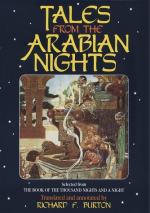in Petis, “History of Fadlallah, Son of Bin
Ortoc, King of Moussel.” The fourth, “Of
Ridzwan-Shah of China and the Shahristani Lady,”
is the second in Petis, “History of King Razvanschad
and of the Princess Cheheristany.” The
eleventh, “Of the Sovereign without a care and
of the Vazir full of care,” is the eighth in
Petis History of King Bedreddin Lolo and of his Vizier
Altalmulc.” The third, “Of the Builder
of Bemm with the two Vazirs of the king of Kawashar,”
the seventh, “Of the Rogue Nasr and the son of
the king of Khurasan,” and the tenth, “The
Three Youths, the Old Man, and the Daughter of the
King,” I cannot, from these titles, recognise
in Petis; while the fifth, “Farrukh-Shad, Farrukh-Ruz,
and Farrukh-Naz,” may be the same as the frame
story of the “Hazar u Yek Ruz,” where
the king is called Togrul-bey, his son Farrukrouz,
and his daughter Farruknaz, and if this be the case,
the Turkish book must differ considerably from the
Persian in its plan.—Although “The
Thousand and One Nights” has not been found
in Persian, there exists a work in that language of
which the plan is somewhat similar—but
adapted from an Indian source. It is thus described
by Dr. Rieu, in his Catalogue of Persian MSS. in the
British Museum, vol. ii. p. 773: Tale of Shirzad,
son of Gurgahan, emperor of China, and Gulshad, daughter
of the vazir Farrukhzad (called the Story of the Nine
Belvideres). Nine tales told by Gulshad to Shirzad,
each in one of the nine belvideres of the royal palace,
in order to save the forfeited life of her father.
[FN#376] A translation of this version, omitting the
moral reflections interspersed, is given by Professor
E. B. Cowell in the “Journal of Philology,”
1876, vol. vi. p. 193. The great Persian mystic
tells another story of a Dream of Riches, which, though
only remotely allied to our tale, is very curious:
The Fakir and the Hidden
Treasure.
Notwithstanding the clear evidence of God’s
bounty, engendering those spiritual tastes in men,
philosophers and learned men, wise in their own conceit,
obstinately shut their eyes to it, and look afar off
for what is really close to them, so that they incur
the penalty of being “branded on the nostrils”
[Kuran, lxviii. 16], adjudged against unbelievers.
This is illustrated by the story of the poor Fakir
who prayed to God that he might be fed without being
obliged to work for his food. A divine voice came
to him in his sleep and directed him to go to the
house of a certain scribe and take a certain writing
he should find there. He did so, and on reading
the writing found that it contained directions for
discovering a hidden treasure. The directions
were as follows: “Go outside the city to
the dome which covers the tomb of the martyr, turn
your back to the tomb and face towards Mecca, place
an arrow in your bow, and where the arrow falls dig
for the treasure.” But before the Fakir
had time to commence the search the rumour of the
writing and its purport had reached the King, who




